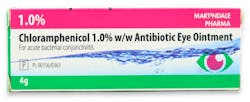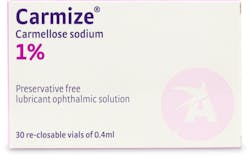Martindale Chloramphenicol 1% w/w Eye Ointment 4g
Martindale Chloramphenicol 1% w/w Eye Ointment 4g
What 500,000+ customers say about medino:
Get notified when back in stock
Description
Acute conjunctivitis is a bacterial infection known as "red eye", with symptoms including reddening of the white part of the eye and a sticky discharge appearing in the eye in the mornings. This and other eye infections can be treated with the antibiotic ointment Chloramphenicol. To combat infections such as bacterial conjunctivitis, Martindale Chloramphenicol 1% w/w Eye Ointment can be applied directly into the eye where the bacteria causing the infection are located.
Key features of Martindale Chloramphenicol 1% w/w Eye Ointment:
- Topical ointment for administration to the eye
- Contain an antibiotic called chloramphenicol
- Used to treat acute bacterial conjunctivitis
- 4g tube
- Suitable for adults and children 2 year old and over
What are common symptoms of conjunctivitis?
Common symptoms include the following:
- redness in the white part of the eye
- red or swollen eyelids
- sticky discharge that can make it difficult to open the eye in the morning
- a feeling of grittiness or irritation of the affected eye(s)
Can Martindale Chloramphenicol 1% w/w Eye Ointment be used by children?
Yes, Martindale Chloramphenicol 1% w/w Eye Ointment can be used by children from the age of 2, but it should be used only under the supervision/guidance of a GP.
Is it safe to use Martindale Chloramphenicol 1% w/w Eye Ointment with contact lenses?
Consult with your optometrist or GP before using this product if you wear contact lenses. Do not wear contact lenses during treatment and if you wear soft contact lenses, wait at least 24 hours after using the eye ointment before putting them back in.
How long does it take for Martindale Chloramphenicol 1% w/w Eye Ointment to work?
The length of time it takes for chloramphenicol ointment to work varies depending on the individual case. Do not exceed five days of treatment without consulting your doctor.
Can I use other eye drops or ointments while using this medication?
It depends on the type of drops - consult with your GP before using any other eye drops or ointments while using chloramphenicol.
What should I do if I miss a dose?
If you miss a dose of chloramphenicol ointment, apply it as soon as you remember. If it is close to the time for your next dose, skip the missed dose and resume your regular dosing schedule.
When should this product not be used?
Chloramphenicol eye ointment is not suitable for treating eye infections that have spread to the deeper layers of the eye coverings or into the fluid within the eyeball. Antibiotic tablets or injections are needed to treat these deeper and more serious infections. Please consult your GP.
Ingredients
Active Ingredient: Chloramphenicol 1% w/w.
Usage and Instructions
How do I use Martindale Chloramphenicol 1% w/w Eye Ointment?
Martindale Chloramphenicol 1% w/w Eye Ointment is applied to the affected eye(s) every 3 to 4 hours (Or as directed by your GP). Before using the ointment, make sure to wash your hands and clean the affected eye(s) with a mild cleanser. To apply, gently pull down your lower eyelid and place a small amount of ointment inside. Close your eye and gently press your finger to the inside corner of the eye for about 1 minute.
After 5 days, throw away any leftover ointment.
For topical administration to the eye.
Warnings
Keep out of sight and reach of children.
Do not use this product if you are allergic to chloramphenicol or any of the listed ingredients.
If the infection doesn't get better within 48 hours or worsens consult your doctor.
After 5 days, throw away any leftover ointment.
For topical administration to the eye.
Side Effects
What are the possible side effects of Martindale Chloramphenicol 1% w/w Eye Ointment?
Some common side effects of Martindale Chloramphenicol 1% w/w Eye Ointment include itching, burning and redness in the white part of the eye. Other potential side effects include sensitivity to light, blurred vision, and mild stinging or burning when the medication is first applied.






